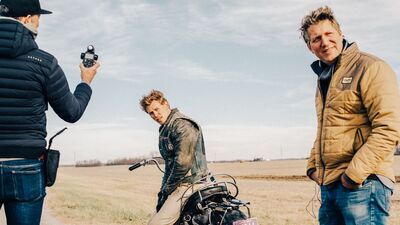You open it up, and the book goes through the entire culture of motorcycle riders. You’ve got Scrambles Track riders, you’ve got mechanics and people building bikes, but then you’ve also got this woman, Kathy, standing in her bathtub. They just felt like the best kinds of photographs, where you’re capturing people as they are, and those people happen to be really compelling.
I was—tangentially, through my brother—part of the punk-rock scene in Little Rock in the ’90s. I loved the detail those people put into their clothes and their style. And you could feel that same sense in these people. There’s a lot of care and thought that went into their style, even though it was a rough-edged kind of style. Their shirts were embroidered; they had these black Western shirts with white piping and beautifully embroidered patches on the back. Then, you get into the text of the book, and these romanticized pictures gain even more of an edge, because you start reading their words and getting this three-dimensional view of a subculture.
Photos have always been an inspiration to me for other films too; certainly, “Mud” was inspired by a book of photographs, [The Last River: Life Along Arkansas’s Lower White, by Turner Browne,] in large part. With those words, you get to see the backside of those photographs and hear the way they think. That’s when I fell in love. That’s when it became more than thinking, “These photos are cool.” I started thinking, “Aren’t these people interesting and frustrating and complex, and everything that you want out of a study of humanity?”

In both Lyon’s book and your film, the story brings a sense of reality to the iconography of the outlaw biker, contextualizing it within larger ’60s counterculture, but not at the expense of the romance, glory, and gratification of that lifestyle. We talk about Lyon’s book as saturation reporting, where you’re more swept up by the subjects than studying them from a sober perspective.
I call it a tension. You have these layers of experience with it — or at least I have, over the last 20 years. Because it starts with the photographs, and then you get into the interviews, and then you hear the people talking, and it doesn’t get easier; it actually gets more difficult. I think this is why it took me a long time to write it, to sit down and face it, because I wanted my film to do all those things, kind of at once. You get this romantic impression at some point in the film, but then the veneer starts to come off a little bit. You start to see the complications in these people. Then you go even further, and it gets downright brutal and tragic, at some point. I wanted to convey not just the first experience of looking at the book but the experience of living with that book for 20 years, which was a deeper experience. I wanted the film to feel like that, which was a hard thing to attempt, but I gave it my best shot.

